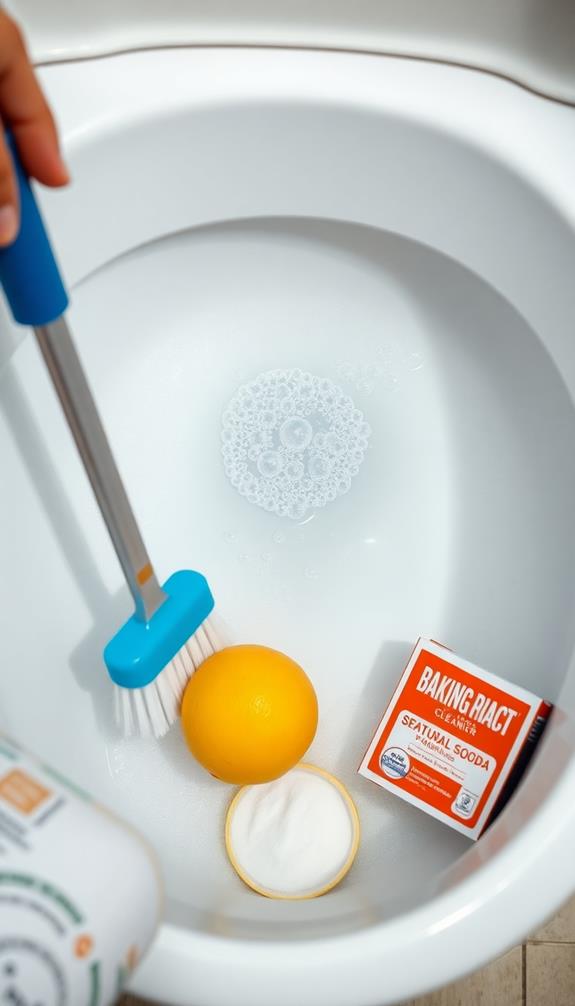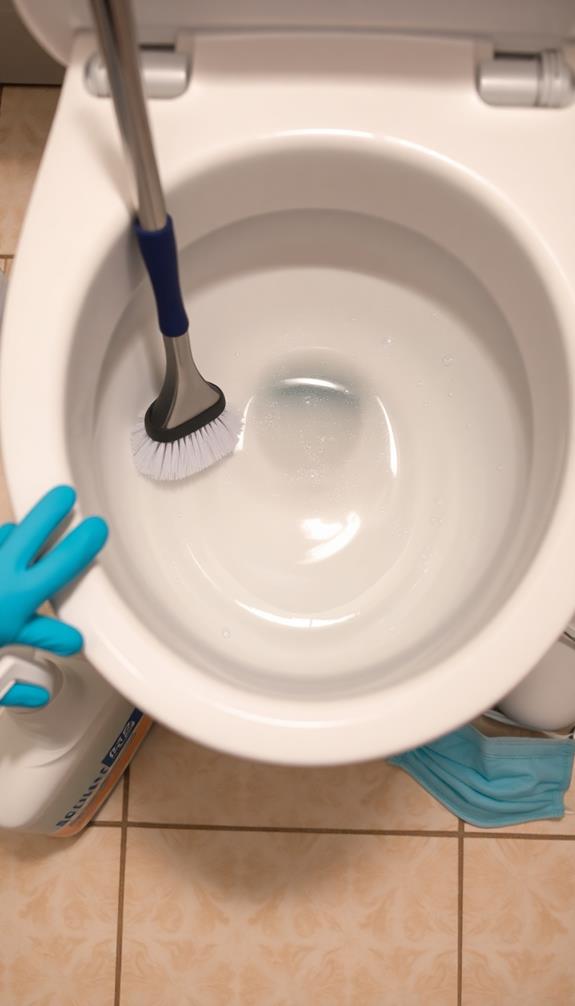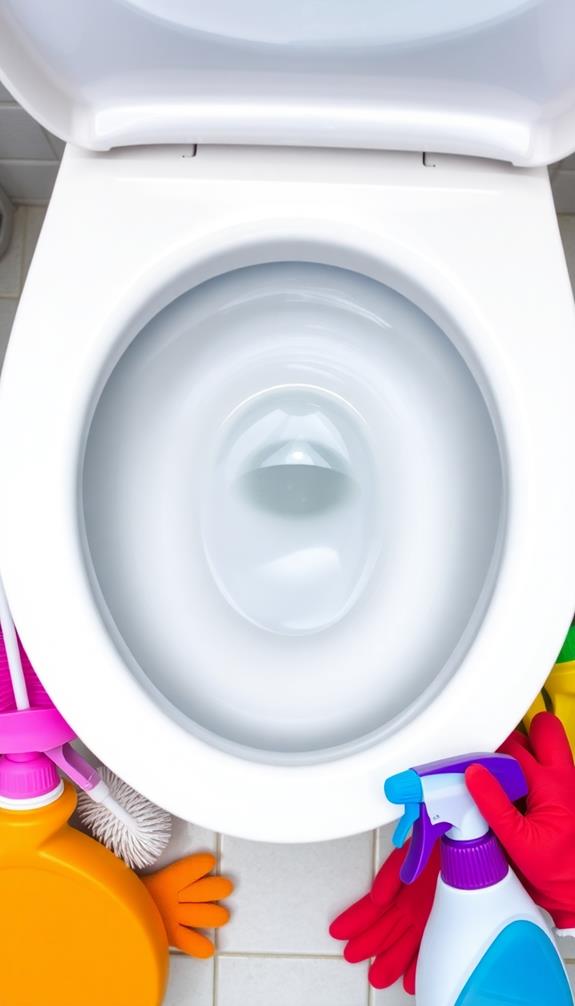To clean toilet stains effectively, start by identifying the type of stain, be it hard water, rust, or mold. Gather essential tools like a toilet brush, scrub brush, and rubber gloves. For light stains, use a mix of vinegar and baking soda; let it sit for 30 minutes before scrubbing. For stubborn stains, try hydrogen peroxide or a pumice stone. Remember to maintain a weekly cleaning routine to prevent future buildup. Safety first—ensure good ventilation and avoid mixing products. Stick around to discover even more tips and techniques for a spotless toilet!
Understanding Toilet Stains
Toilet stains can be a nuisance, but understanding what causes them is the first step toward effective cleaning.
Toilet bowl stains typically fall into a few categories, each requiring a different approach. Hard water stains, for instance, arise from mineral buildup, primarily calcium and magnesium, found in untreated water. If you notice yellow or brown discoloration in your toilet bowl, you're likely dealing with hard water stains.
Cleaning supplies like pumice stones or acidic cleaners can be particularly effective against these types of stains.
Rust stains are another common issue, appearing as dark brown or red marks. These often stem from corroded pipes or high iron content in your water supply. If you've got rust, you'll need a specific cleaning method to tackle it effectively.
Mold growth, characterized by dark green or black spots, usually develops near the water line in damp conditions. Poor ventilation and moisture accumulation are the main culprits behind this unsightly stain.
Identifying the type of stain is essential; once you know whether it's hard water stains, rust, or mold growth, you can select the most effective cleaning method and prevent future occurrences.
Understanding these factors will make your cleaning process much easier and more efficient.
Essential Tools and Preparations
Equipping yourself with the right tools is essential for tackling toilet stains effectively. Before you start, gather the following essential tools to streamline your cleaning process:
- Toilet Brush: This is your primary tool for scrubbing stains inside the bowl.
- Scrub Brush: Use this for tougher stains on the toilet exterior or under the rim.
- Rubber Gloves: Protect your hands from germs and harsh cleaning solutions. Utilizing specific products for calcium buildup removal can enhance your cleaning efforts.
Next, prepare your cleaning solutions in advance. Vinegar and baking soda or citric acid make excellent natural options that tackle stains without harsh chemicals. Having these ready will save you time during the cleaning process.
Don't forget about proper ventilation! Open a window or turn on the exhaust fan to minimize the inhalation of any chemical fumes.
Also, clear off any items from the top of the toilet tank to create a clean workspace.
Lastly, allocate about 10-20 minutes to guarantee you thoroughly address all areas. With the right tools and preparations in place, you're ready to make that toilet sparkle!
Effective Cleaning Techniques

Cleaning your toilet effectively requires a few tried-and-true techniques that can tackle various types of stains. To prevent the accumulation of stains and mineral deposits, make it a habit to clean your toilet bowl at least once a week.
For light stains, a simple mixture of vinegar and baking soda works wonders. This combination not only cleans effectively but is also a non-toxic cleaning solution that guarantees family safety. Pour it into the bowl, scrub, and let it sit for 30 minutes before rinsing.
If you encounter stubborn stains, you may need to reach for more potent cleaning products. Citric acid or hydrogen peroxide can be effective; just apply these solutions directly to the stains and let them work their magic for 30-60 minutes before scrubbing.
For hard water stains or rust, a pumice stone can gently remove stains without scratching the porcelain surface.
Always prioritize safety by guaranteeing proper ventilation and wearing rubber gloves when using chemical cleaners. This protects your skin and helps you avoid harmful fumes while you work.
With these effective cleaning techniques, you'll keep your toilet looking fresh and stain-free, making your cleaning routine a breeze!
Dealing With Stubborn Stains
Even with regular cleaning, stubborn stains like limescale or hard water deposits can still appear. You can also consider using some eco-friendly methods for cleaning your toilet, as these natural alternatives are effective and safe for the environment.
Don't worry; you can tackle these tough stains effectively. Here's how to remove the stains using some practical methods:
- White Vinegar Soak: Pour white vinegar into the toilet bowl, covering the affected area. Let it soak for several hours or overnight. Afterward, scrub with a toilet brush to lift the stains.
- Baking Soda and Vinegar Paste: Mix baking soda and vinegar to create a paste. Apply it directly to the stubborn toilet bowl stains and let it sit for 10-15 minutes. Scrub with your toilet brush to break down the mineral buildup.
- Hydrogen Peroxide Treatment: Pour ½ cup of hydrogen peroxide into the bowl. Allow it to sit for 30 minutes, then scrub with a toilet brush for a thorough clean.
If you have rust stains, consider using a pumice stone. Just remember to soak the stone in water first to prevent scratching.
Maintenance and Safety Measures

To keep your toilet clean and stain-free, establish a regular cleaning schedule, ideally once a week.
Utilizing effective disinfectants, such as Seventh Generation or Clorox Wipes, can greatly enhance your cleaning routine.
Always prioritize safety by wearing protective gloves and ensuring the bathroom is well-ventilated when using chemical cleaners.
Avoid mixing different products to prevent any harmful reactions that could put you at risk.
Regular Cleaning Schedule
A well-planned cleaning schedule is essential for maintaining a spotless toilet and preventing stubborn stains.
To achieve this, it's vital to establish a routine that suits your household needs. Here's how to create an effective regular cleaning schedule:
- Weekly Cleaning: Clean the toilet bowl at least once a week to prevent stains and grime buildup. This routine helps keep your toilet in good condition.
- Increase Frequency: If you have hard water or a high-traffic bathroom, consider cleaning more frequently. This extra effort will minimize future staining and maintain cleanliness.
- Preventive Measures: Implementing solutions like a water softener can considerably reduce hard water stains over time, making your cleaning tasks easier.
Safety Precautions During Cleaning
Guaranteeing safety during toilet cleaning is vital to protect yourself from harmful chemicals and potential accidents. Start by prioritizing proper ventilation; open windows or turn on exhaust fans to minimize inhaling fumes from cleaning products. Good airflow helps keep the air fresh and reduces the risk of respiratory irritation.
Next, always wear rubber gloves to shield your skin from harsh chemicals and irritants. This simple step can prevent rashes and allergic reactions, allowing you to clean effectively without harming yourself.
Before using any cleaning product, make certain to read and follow the label instructions and warnings carefully. This will help you avoid any harmful reactions or misuse.
Also, avoid mixing different cleaning products, especially those containing bleach and acids, as this can release toxic gases that are dangerous to your health.
Lastly, be aware of your toilet's material. Choosing appropriate cleaners that won't damage porcelain or other surfaces is essential.
Natural Cleaning Methods
You can easily tackle toilet stains with natural ingredients you probably already have at home.
Using items like vinegar, baking soda, and lemon juice, you can create effective cleaning solutions that not only remove stains but also deodorize your toilet.
These green methods to clean aren't only safe for your home but also environmentally friendly.
Let's walk through the step-by-step application process to keep your toilet sparkling clean.
Effective Natural Ingredients
Utilizing natural ingredients for toilet cleaning not only guarantees a sparkling clean bowl but also promotes a healthier home environment.
Here's a quick look at some effective natural ingredients you can use:
- Vinegar and Baking Soda: This dynamic duo works wonders. Pour vinegar into the bowl, followed by a sprinkle of baking soda. This combination disinfects and eliminates odors while whitening your toilet.
- Hydrogen Peroxide: Pouring ½ cup of hydrogen peroxide into the toilet can lift early-stage stains and disinfect the area. Let it sit for about 30 minutes before you scrub. It's a non-toxic and affordable option that really packs a punch.
- Borax: If you're dealing with stubborn mold and mildew, sprinkle Borax in the bowl and let it sit overnight. This powerful ingredient tackles growth and odors effectively, ensuring your toilet remains fresh.
Step-by-Step Application Process
Cleaning toilet stains can feel intimidating, but with the right approach, it becomes a straightforward task. Start by identifying the type of stains in your toilet bowl—whether they're hard water, rust, or mold. This helps you choose the most effective natural cleaning method.
For hard water stains, mix baking soda with vinegar to form a paste. Apply this to the stained areas and let it sit for about 10 minutes before scrubbing with a toilet brush.
If you're dealing with mold or mildew, create a spray using lemon juice and water. Spray it directly on the affected areas and allow it to sit for 20 minutes before scrubbing and flushing.
Another great non-toxic option is hydrogen peroxide. Pour ½ cup into the toilet bowl, let it sit for 30 minutes, then scrub with your toilet brush and flush.
To keep your toilet clean and prevent future stains, make sure to apply these natural methods at least once a week. With consistent effort, you'll maintain a sparkling toilet bowl without the need for harsh chemicals.
Customer Benefits and Cleaning Techniques

When it comes to maintaining a spotless toilet, the right cleaning techniques can make all the difference. Utilizing professional cleaning services, like those from Molly Maid, guarantees that trained experts use specialized tools and eco-friendly products for effective stain removal.
Regular disinfection is also vital for a hygienic bathroom environment, as it helps prevent the buildup of harmful bacteria and keeps your toilet safe for family use. However, you can also incorporate regular cleaning techniques at home to keep your toilet fresh.
Here are three essential methods to help you clean toilet bowl stains effectively:
- Vinegar and Baking Soda: This dynamic duo can tackle minor stains and maintain cleanliness. Pour vinegar into the bowl, add baking soda, and let it fizz before scrubbing.
- Hydrogen Peroxide: For rust stains, hydrogen peroxide works wonders. Apply it to the affected area and let it sit before scrubbing.
- Routine Maintenance: Schedule regular cleanings to prevent tough stains from forming, making upkeep easier.
Conclusion
By following these steps, you can tackle toilet stains effectively and keep your bathroom looking fresh. For instance, a homeowner named Sarah noticed persistent hard water stains in her toilet. After using a combination of vinegar and baking soda, she not only eliminated the stains but also improved the overall hygiene of her bathroom. Regular maintenance and the right techniques will guarantee your toilet remains spotless and welcoming for years to come.